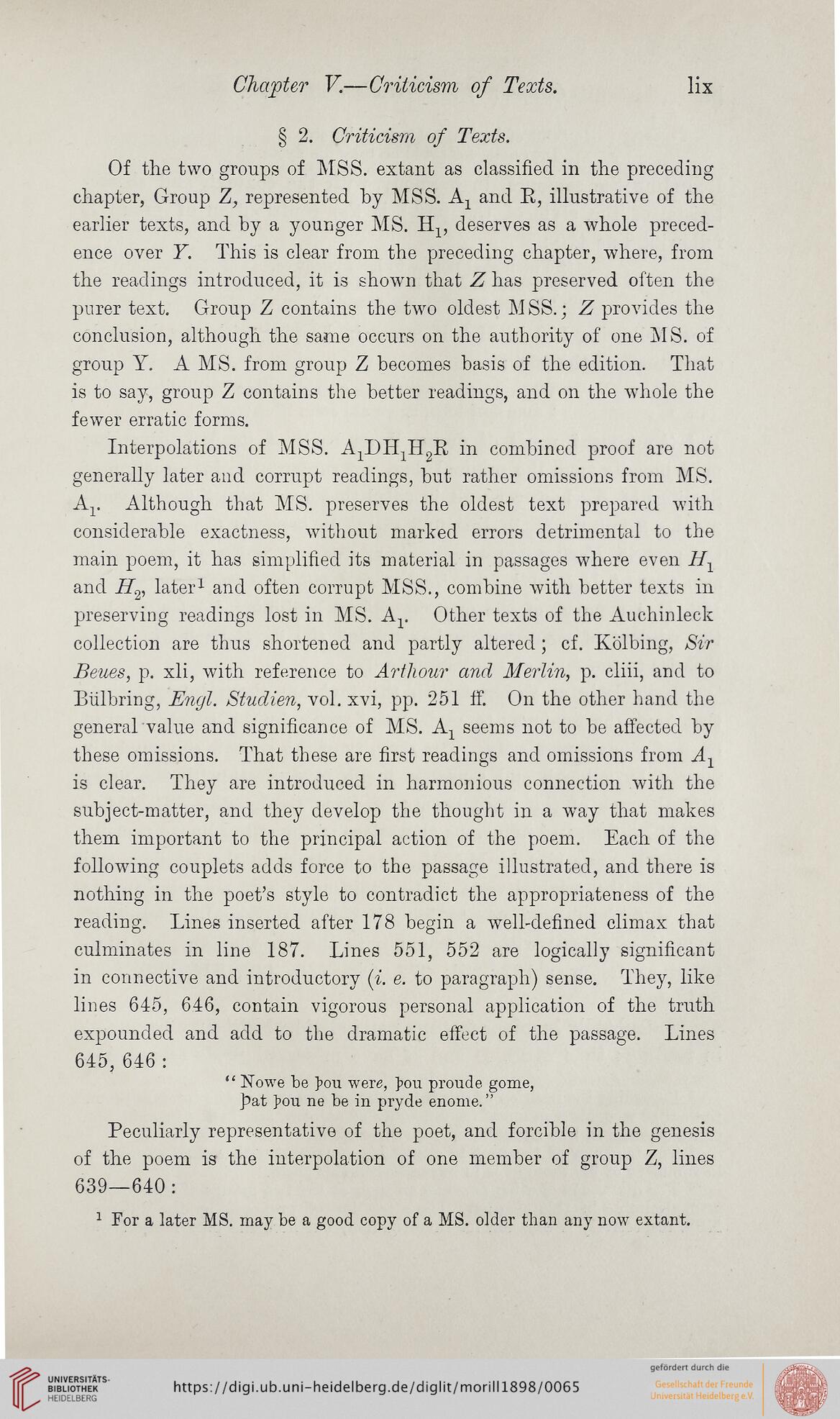Chapter V.—Criticism of Texts. lix
§ 2. Criticism of Texts.
Of the two groups of MSS. extant as classified in the preceding
chapter, Group Z, represented by MSS. Ax and R, illustrative of the
earlier texts, and by a younger MS. H1, deserves as a whole preced-
ence over E. This is clear from the preceding chapter, where, from
the readings introduced, it is shown that Z has preserved often the
purer text. Group Z contains the two oldest MSS.; Z provides the
conclusion, although the same occurs on the authority of one AIS. of
group Y. A MS. from group Z becomes basis of the edition. That
is to say, group Z contains the better readings, and on the whole the
fewer erratic forms.
Interpolations of MSS. A1DH1H2R in combined proof are not
generally later and corrupt readings, but rather omissions from MS.
A1. Although that MS. preserves the oldest text prepared with
considerable exactness, without marked errors detrimental to the
main poem, it has simplified its material in passages where even H1
and If, later1 and often corrupt MSS., combine with better texts in
preserving readings lost in MS. Ax. Other texts of the Auchinleck
collection are thus shortened and partly altered; cf. Kolbing, Sir
Beues, p. xli, with reference to Arthour and Merlin, p. cliii, and to
Bulbring, Engl. Studien, vol. xvi, pp. 251 ff. On the other hand the
general value and significance of MS. Ax seems not to be affected by
these omissions. That these are first readings and omissions from A1
is clear. They are introduced in harmonious connection with the
subject-matter, and they develop the thought in a way that makes
them important to the principal action of the poem. Each of the
following couplets adds force to the passage illustrated, and there is
nothing in the poet’s style to contradict the appropriateness of the
reading. Lines inserted after 178 begin a well-defined climax that
culminates in line 187. Lines 551, 552 are logically significant
in connective and introductory (i. e. to paragraph) sense. They, like
lines 645, 646, contain vigorous personal application of the truth
expounded and add to the dramatic effect of the passage. Lines
645,646 :
“ Nowe be ]>ou were, pou proud e gome,
pat pou ne be in pryde enome. ”
Peculiarly representative of the poet, and forcible in the genesis
of the poem is the interpolation of one member of group Z, lines
639—640:
1 For a later MS. may be a good copy of a MS. older than any now extant.
§ 2. Criticism of Texts.
Of the two groups of MSS. extant as classified in the preceding
chapter, Group Z, represented by MSS. Ax and R, illustrative of the
earlier texts, and by a younger MS. H1, deserves as a whole preced-
ence over E. This is clear from the preceding chapter, where, from
the readings introduced, it is shown that Z has preserved often the
purer text. Group Z contains the two oldest MSS.; Z provides the
conclusion, although the same occurs on the authority of one AIS. of
group Y. A MS. from group Z becomes basis of the edition. That
is to say, group Z contains the better readings, and on the whole the
fewer erratic forms.
Interpolations of MSS. A1DH1H2R in combined proof are not
generally later and corrupt readings, but rather omissions from MS.
A1. Although that MS. preserves the oldest text prepared with
considerable exactness, without marked errors detrimental to the
main poem, it has simplified its material in passages where even H1
and If, later1 and often corrupt MSS., combine with better texts in
preserving readings lost in MS. Ax. Other texts of the Auchinleck
collection are thus shortened and partly altered; cf. Kolbing, Sir
Beues, p. xli, with reference to Arthour and Merlin, p. cliii, and to
Bulbring, Engl. Studien, vol. xvi, pp. 251 ff. On the other hand the
general value and significance of MS. Ax seems not to be affected by
these omissions. That these are first readings and omissions from A1
is clear. They are introduced in harmonious connection with the
subject-matter, and they develop the thought in a way that makes
them important to the principal action of the poem. Each of the
following couplets adds force to the passage illustrated, and there is
nothing in the poet’s style to contradict the appropriateness of the
reading. Lines inserted after 178 begin a well-defined climax that
culminates in line 187. Lines 551, 552 are logically significant
in connective and introductory (i. e. to paragraph) sense. They, like
lines 645, 646, contain vigorous personal application of the truth
expounded and add to the dramatic effect of the passage. Lines
645,646 :
“ Nowe be ]>ou were, pou proud e gome,
pat pou ne be in pryde enome. ”
Peculiarly representative of the poet, and forcible in the genesis
of the poem is the interpolation of one member of group Z, lines
639—640:
1 For a later MS. may be a good copy of a MS. older than any now extant.




